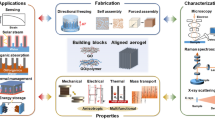Abstract
A simple and effective method for the preparation of amphiphilic graphene (AG) is presented under an organic solvent-free synthetic condition. The synthetic route first involves a cyclization reaction between carboxylic groups on graphene oxide and the amino groups on 5,6-diaminopyrazine-2,3-dicarbonitrile, and subsequent reduction by hydrazine. Results of UV-vis spectroscopy, Fourier transformed infrared spectroscopy (FT-IR), X-ray photoelectron spectroscopy (XPS), thermogravimetric analysis (TGA) and Raman spectroscopy have confirmed that the covalent functionalization of graphene can be achieved through the formation of imidazo[4,5-b]pyrazine on the graphene sheets. As a result, AG can be successfully dispersed in water and common organic solvents. This work successfully provides a facile and efficient way to fabricate AG and may extend the potential applications of graphene-based materials in nanoelectronic devices, polymer fillers and biological field.
Similar content being viewed by others
References
Cai D, Song M. Recent advance in functionalized graphene/polymer nanocomposites. J Mater Chem, 2010, 20: 7906–7915
Eda G, Chhowalla M. Chemically derived graphene oxide: Towards large-area thin-film electronics and optoelectronics. Adv Mater, 2010, 22: 2392–2415
Ai W, Xie L H, Du Z Z, et al. A novel graphene-polysulfide anode material for high-performance lithium-ion batteries. Sci Rep, 2013, 3: 2341
Lou K P, Bao Q, Ang P K, et al. The chemistry of graphene. J Mater Chem, 2010, 20: 2277–2289
Ai W, Zhou W, Du Z, et al. Benzoxazole and benzimidazole heterocycle-grafted graphene for high-performance supercapacitor electrodes. J Mater Chem, 2012, 22: 23439–23446
Zhuang X D, Chen Y, Liu G, et al. Conjugated-polymer-functionalized graphene oxide: synthesis and nonvolatile rewritable memory effect. Adv Mater, 2010, 22: 1731–1735
Liu F, Sun J, Zhu L, et al. Sulfated graphene as an efficient solid catalyst for acid-catalyzed liquid reactions. J Mater Chem, 2012, 22: 5495–5502
Ai W, Liu J Q, Du Z Z, et al. One-pot, aqueous-phase synthesis of graphene oxide functionalized with heterocyclic groups to give increased solubility in organic solvents. RSC Adv, 2013, 3: 45–49
Lee D W, De Los Santos V L, Seo J W, et al. The structure of graphite oxide: Investigation of its surface chemical groups. J Phys Chem B, 2010, 114: 5723–5728
Yi M D, Zhao L T, Fan Q L, et al. Electrical characteristics and carrier transport mechanisms of write-once-read-many-times memory elements based on graphene oxide diodes. J Appl Phys, 2011, 110: 063709
Verdejo R, Bernal M M, Romasantal J, et al. Graphene filled polymer nanocomposites. J Mater Chem, 2011, 21: 3301–3310
Georgakilas V, Otyepka M, Bourlinos A B, et al. Functionalization of graphene: Covalent and non-covalent approaches, derivatives and applications. Chem Rev, 2012, 112: 6156–6214
Liu Z, Robinson J T, Sun X, et al. PEGylated nanographene oxide for delivery of water-insoluble cancer drugs. J Am Chem Soc, 2008, 130: 10876–10877
Zhong Z, Dai Y, Ma D, et al. Facile synthesis of organo-soluble surface-grafted all-single-layer graphene oxide as hole-injecting buffer material in organic light-emitting diodes. J Mater Chem, 2011, 21: 6040–6045
Ai W, Du Z Z, Liu J Q, et al. Formation of graphene oxide gel via the π-stacked supramolecular self-assembly. RSC Adv, 2012, 2: 12204–12209
Du Z Z, Li W, Ai W, et al. Chemoselective reduction of graphene oxide and its application in nonvolatile organic transistor memory devices. RSC Adv, 2013, 3: 25788–25791
Krieble V K, Noll C I. The hydrolysis of nitriles with acids. J Am Chem Soc, 1939, 61: 560–563
Li M, Cushing S K, Zhou X, et al. Fingerprinting photoluminescence of functional groups in graphene oxide. J Mater Chem, 2012, 22: 23374–23379
Author information
Authors and Affiliations
Corresponding authors
Rights and permissions
About this article
Cite this article
Du, Z., Ai, W., Zhao, J. et al. Synthesis and characterization of amphiphilic graphene. Sci. China Technol. Sci. 57, 244–248 (2014). https://doi.org/10.1007/s11431-014-5454-z
Received:
Accepted:
Published:
Issue Date:
DOI: https://doi.org/10.1007/s11431-014-5454-z




